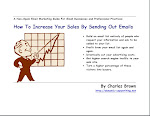I could call this article, “More Great Moments in Wasteful Advertising,” but I’m saving that one for the future. I’m sure I’ll get another opportunity to use it soon.
On the back cover of the latest Fast Company magazine (the January 2007 issue), is a big, expensive ad from the software company, SAP. They have a picture of an average-looking guy with a headline that says,
“SAP Has Affordable Solutions For Midsize Companies?
This Better Not Be Another Prank By The Guys in Procurement.”
Yes, it is an amusing ad, but it communicates nothing other than the fact that SAP does something or other for midsize companies as well as the big boys.
Well whoopee! If you look really close, there is a quasi benefit that sort of limps onto the ad down at the bottom where the copy reads, “..modular solutions that let you buy only the software you need now…” And then this poor little benefit wannabe limps back off stage never to be seen again.
I’m all for offering solutions, except when you just offer “solutions.” In other words, go ahead and solve actual problems, but don’t throw the word “solutions” around as if it is code for all kinds of wonderful things you can do for me.
“Solutions” (the word) is bandied about in all kinds of ads these days, without specific examples of problems being solved. “Solutions” has become a buzzword meant to replace the hard work of showing problems getting taken care of.
To quote from the classic movie, Cool Hand Luke, “what we have here is failure to communicate.”
Copywriters use the word “solutions” because it sounds nice and because it is a lot less work than narrowing the scope of an ad by specifying certain needs.
But, my offended copywriting colleagues say, “if you narrow the scope of the ad to only those readers who are affected by this particular problem, you exclude all those readers who are not affected by it.
Yep, that’s right. That is the beauty of targeting a niche. Now SAP could solve this problem of excluding some readers (did you notice I just tied the word “solve” to a specific problem?) in one of two ways.
First, they could run a series of ads, each targeting certain audiences by focusing on certain problems and solutions. Chances are these targeted ads will grab those targeted readers much more than the bland generality they are running now.
Second, they could run a single ad with a menu of problems and offer a free booklet to IT managers, CFOs or other managers who identify with one or more of those problems. Now to be fair, the Fast Company ad does mention their website at the very bottom of the ad. It is a lame mention that says, “learn more at sap.com/midsize.”
Directing a reader to your website, before you have aroused her interest, is expecting the customer to do all your work for you. For every one person this ad gets to check out the website, 10,000 will yawn and forget it.
But, by offering a free booklet or guide, and promising tons of benefits which will be contained within its pages, SAP could not only attract much more interest, they could also generate a lot of leads to be followed up on later.
To sum all this up, when you see the word “solutions” used as a buzzword, you are seeing the work of a lazy copywriter or marketer. Benefits are solutions, but always use it as a specific cure for a specific problem.
For all the money SAP surely spent on this ad, they really should be able to do better.
COPYRIGHT © 2006, Charles Brown

Subscribe to:
Post Comments (Atom)



0 comments:
Post a Comment